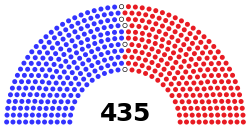
Back Amerikaanse Kongres Afrikaans Mōt þāra Geānedra Rīca American ANG الكونغرس الأمريكي Arabic كونجرس امريكا ARZ Congresu de los Estaos Xuníos AST ABŞ Konqresi Azerbaijani آمریکا کنگرهسی AZB United States Congress BAR Кангрэс Злучаных Штатаў Амерыкі Byelorussian Кангрэс ЗША BE-X-OLD
This article may rely excessively on sources too closely associated with the subject, potentially preventing the article from being verifiable and neutral. (May 2024) |
United States Congress | |
|---|---|
| 118th United States Congress | |
 | |
| Type | |
| Type | |
| Houses | Senate House of Representatives |
| History | |
| Founded | March 4, 1789 |
| Preceded by | Congress of the Confederation |
New session started | January 3, 2023 |
| Leadership | |
| Structure | |
| Seats |
|
 | |
Senate political groups | Majority (51)
Minority (49)
|
 | |
House of Representatives political groups | Majority (220)
Minority (212)
Vacant (3)
|
| Elections | |
Last Senate election | November 5, 2024 |
Last House of Representatives election | November 5, 2024 |
Next Senate election | November 3, 2026 |
Next House of Representatives election | November 3, 2026 |
| Meeting place | |
 | |
| United States Capitol Washington, D.C. United States of America | |
| Website | |
| congress | |
| Constitution | |
| United States Constitution, article I | |
| This article is part of a series on the |
| Politics of the United States |
|---|
 |
The United States Congress is the legislature of the federal government of the United States. It is bicameral, composed of a lower body, the United States House of Representatives, and an upper body, the United States Senate. It meets in the United States Capitol in Washington, D.C. Members are chosen through direct election,[b] though vacancies in the Senate may be filled by a governor's appointment. Congress[c] has 535 voting members: 100 senators and 435 representatives. The vice president of the United States, as President of the Senate, has a vote in the Senate only when there is a tie. The House of Representatives has six non-voting members.[6]
Congress convenes for a two-year term, commencing every other January. Elections are held every even-numbered year on Election Day. The members of the House of Representatives are elected for the two-year term of a Congress. The Reapportionment Act of 1929 established that there be 435 representatives, and the Uniform Congressional Redistricting Act requires that they be elected from single-member constituencies or districts. It is also required that the congressional districts be apportioned among states by population every ten years using the U.S. census results, provided that each state has at least one congressional representative. Each senator is elected at-large in their state for a six-year term, with terms staggered, so every two years approximately one-third of the Senate is up for election. Each state, regardless of population or size, has two senators, so currently, there are 100 senators for the 50 states.
Article One of the U.S. Constitution requires that members of Congress be at least 25 years old for the House and at least 30 years old for the U.S. Senate, be a U.S. citizen for seven years for the House and nine years for the Senate, and be an inhabitant of the state which they represent. Members in both chambers may stand for re-election an unlimited number of times.
The Congress was created by the U.S. Constitution and first met in 1789, replacing the Congress of the Confederation in its legislative function. Although not legally mandated, in practice since the 19th century, members of Congress are typically affiliated with one of the two major parties, the Democratic Party or the Republican Party, and only rarely with a third party or independents affiliated with no party. In the case of the latter, the lack of affiliation with a political party does not mean that such members are unable to caucus with members of the political parties. Members can also switch parties at any time, although this is quite uncommon.
- ^ "Maine Independent Angus King To Caucus With Senate Democrats". Politico. November 14, 2012. Archived from the original on December 8, 2020. Retrieved November 28, 2020.
Angus King of Maine, who cruised to victory last week running as an independent, said Wednesday that he will caucus with Senate Democrats. [...] The Senate's other independent, Bernie Sanders of Vermont, also caucuses with the Democrats.
- ^ "Senate group eyes Social Security changes as Biden hits Republicans over benefits". NBC News. March 3, 2023. Archived from the original on August 31, 2023. Retrieved August 31, 2023.
- ^ Schonfeld, Zach (December 11, 2022). "Sanders calls Sinema 'corporate Democrat' who 'sabotaged' legislation". Archived from the original on August 31, 2023. Retrieved August 31, 2023.
- ^ "Sinema Trashes Dems: 'Old Dudes Eating Jell-O'". POLITICO. March 23, 2023. Archived from the original on October 8, 2023. Retrieved August 31, 2023.
- ^ Garner, Bryan A. (2011). Garner's Dictionary of Legal Usage (3rd ed.). Oxford: Oxford University Press. p. 203. ISBN 9780195384208. Retrieved October 22, 2023.
- ^ "Membership of the 116th Congress: A Profile". Congressional Research Service. p. 4. Archived from the original on January 14, 2021. Retrieved March 5, 2020.
Congress is composed of 541 individuals from the 50 states, the District of Columbia, Guam, the U.S. Virgin Islands, American Samoa, the Northern Mariana Islands, and Puerto Rico.
Cite error: There are <ref group=lower-alpha> tags or {{efn}} templates on this page, but the references will not show without a {{reflist|group=lower-alpha}} template or {{notelist}} template (see the help page).
